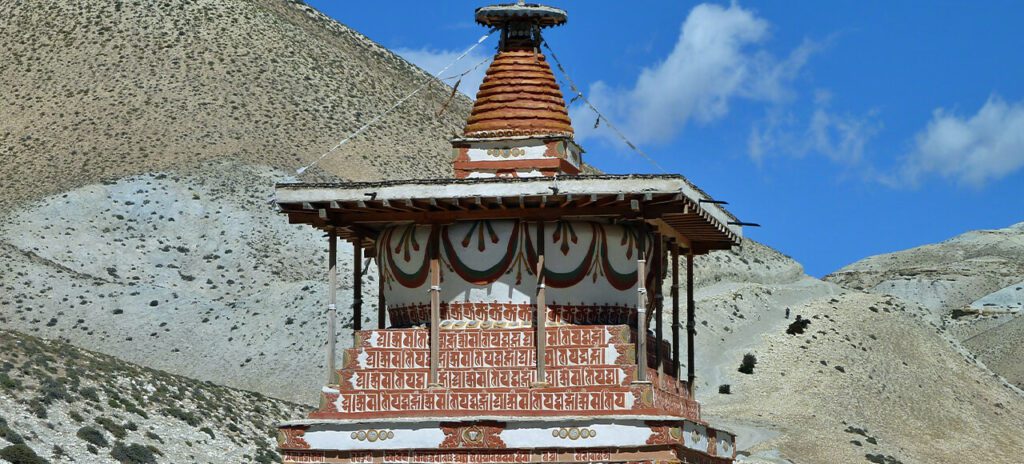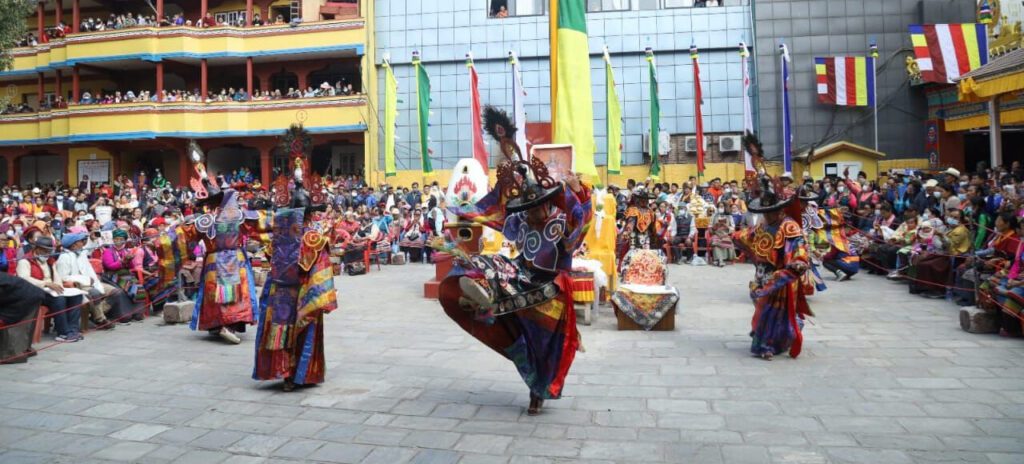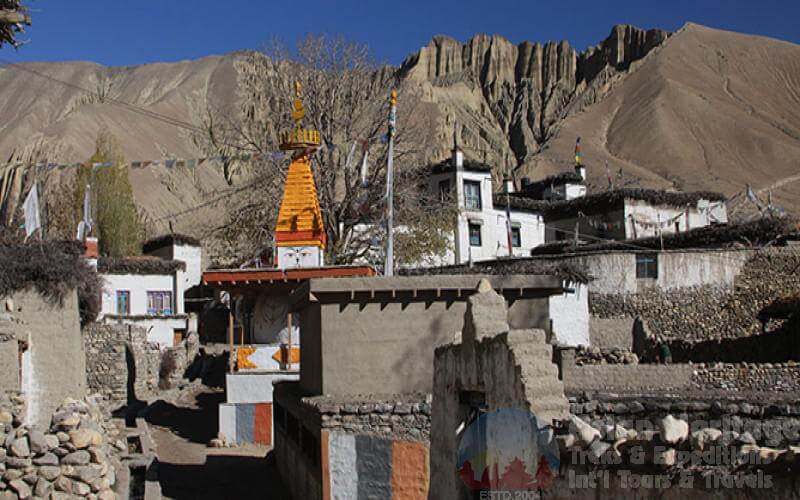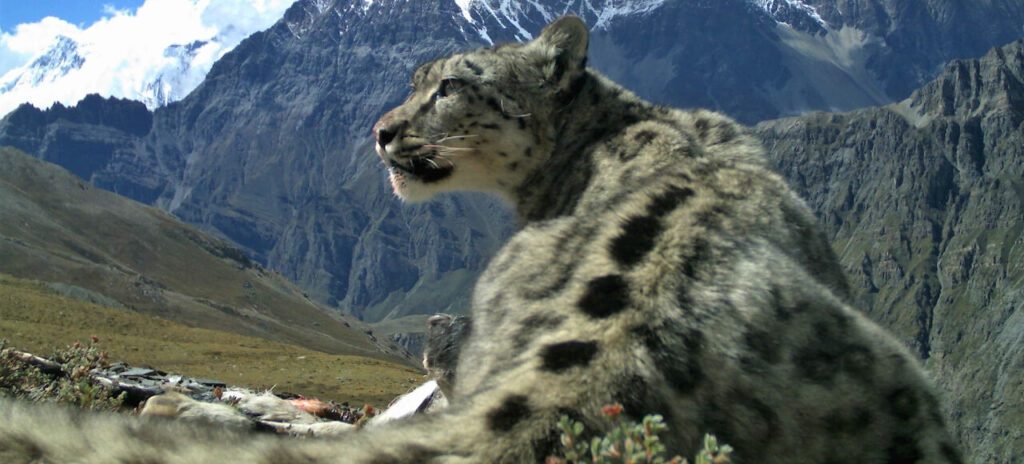Upper Mustang Trek in February- Are you ready for an adventure like no other? Imagine trekking through the snow-covered landscapes of the remote Upper Mustang region of Nepal in February. The biting cold and occasional snowfall make the journey challenging, but the reward is an unforgettable experience of a lifetime.
As you set foot on the trekking trails, the imposing Himalayan mountain range looms above you, showcasing its breathtaking beauty against the clear blue sky. The silence is deafening, broken only by the sound of your footsteps crunching on the snow and the occasional chirping of birds. The barren cliffs and deep canyons offer a unique and fascinating view, unlike anything you’ve ever seen.
Location and Altitude
The Upper Mustang trek is located in the Mustang district of Nepal, in the Annapurna Conservation Area. It is a remote and culturally rich region that was once an independent kingdom and is now known as the “Last Forbidden Kingdom”. The trek begins from the town of Jomsom which is accessible by a 25-minute flight from Pokhara.
The altitude of the Upper Mustang trek varies throughout the route, ranging from 2,800 meters in Kagbeni to 4,200 meters at the Lo La Pass. The average altitude on the trek is around 3,500 meters. It is a high-altitude trek and involves crossing several passes, including the Chogo La Pass and the Lo La Pass.
Weather Conditions and Temperature
If you’re an adventurous trekker who wants to experience the unique culture and breathtaking landscapes of the Upper Mustang region of Nepal, February can be an ideal time to plan your trip. However, it’s important to understand the weather conditions and prepare accordingly to make the most of your trekking experience.

February is considered one of the driest months of the year in Upper Mustang, with very little rainfall or snowfall. The temperature in Upper Mustang in February is typically cold and dry, with temperatures ranging from -15°C (5°F) to 10°C (50°F) during the day, and dropping to as low as -20°C (-4°F) at night. While the temperature gradually increases as the month progresses, it’s still quite cold overall, especially at higher elevations.
Also Read: Upper Mustang Trek in January: Travel Tips, Weather, and More
The clear and sunny days of February offer spectacular views of the snow-capped mountains and the barren landscape of Upper Mustang. However, occasional snowfall and blizzards can occur, especially at higher elevations, which can make trekking difficult. The dry and dusty trail can also cause respiratory problems for some trekkers.
Crowd
In February, the weather in Upper Mustang is cold and dry, and the temperatures can drop below freezing, which can be a deterrent for some visitors. Additionally, some of the roads leading to Upper Mustang may be closed due to snow which can limit access to the region.
Despite these factors, Upper Mustang still receives a fair number of visitors in February, as it is considered a good time for trekking in the region. However, the crowds are much smaller than during the peak season, and visitors can enjoy a more peaceful and less crowded trekking experience.
Festival
Losar
In Upper Mustang, Losar is celebrated with great enthusiasm and is an important cultural event for the local Tibetan community. The Losar celebrations in Upper Mustang usually last for several days and involve a range of traditional customs and rituals. One of the key traditions is the cleaning of homes and monasteries in the weeks leading up to Losar. This is seen as a way to symbolically sweep away any negative energy from the old year and make way for the new.

On the first day of Losar, families gather together to offer prayers and make offerings at the local monastery. This is followed by a feast, where traditional dishes such as “Khapse” is served. The festivities continue throughout the day, with music, dancing, and other cultural activities.
Highlights of the Upper Mustang Trek in February
Trekking in February in Upper Mustang is an excellent time to experience the region when the skies are clear, and the views are stunning. Let’s highlight some of the best things to see and do on the Upper Mustang trek in February.
Beautiful Scenery:
The Upper Mustang trek in February offers incredible views of the stunning Himalayan Mountains, which are snow-capped and glorious. The trek takes you through arid valleys and rocky terrain, with ancient villages and monasteries dotted along the way. The skies are clear during February, and you can enjoy spectacular sunrises and sunsets. The landscapes are rugged and raw, with the striking contrast of red and brown cliffs against the white snow.

Unique Culture:
The Upper Mustang region is a unique blend of Nepalese and Tibetan cultures, with many ancient traditions still intact. The people of Upper Mustang are warm and friendly, and you will have the opportunity to visit ancient monasteries and meet local people. The region has a distinct culture, and you will see ancient prayer flags fluttering in the wind, Chortens (stupas), and mani walls (prayer wheels) as you trek through the region.
Historical sites:
The Upper Mustang region is home to many ancient historical sites including the 15th-century palace of the former King of Mustang. The palace is an incredible example of ancient architecture, with intricate carvings and stunning artwork.
You may also like: Upper Mustang Trek Cost: Permits, Expenses, and More
Other historical sites include ancient monasteries such as Lo Gekar Monastery which dates back to the 8th century.
Tranquill trekking:
The Upper Mustang trek in February is relatively peaceful and tranquil, as it is not peak season for trekking. The trails are not crowded and you will have plenty of opportunities to take in the stunning scenery and enjoy the peace and quiet of the region. Trekking in February also means that the weather is cooler, making it easier to trek through the rugged terrain.
Animals that can be spotted during Upper Mustang Trek
Upper Mustang is a fascinating region of Nepal, with a unique landscape and diverse wildlife. If you are planning a trek in February, there are several interesting faunas that you can spot during your journey.
Snow Leopard:
One of the most sought-after sightings in the Upper Mustang region is the elusive snow leopard. These majestic cats are known to inhabit the high-altitude regions of the Himalayas including Upper Mustang. However, spotting a snow leopard requires patience, perseverance, and a bit of luck.

Himalayan Blue Sheep:
Another common sighting in the Upper Mustang region is the Himalayan Blue Sheep, also known as the Bharal. These wild sheep are adapted to the harsh mountain environment and are often seen grazing on steep hillsides.
Himalayan Griffon:
The Himalayan Griffon, a large vulture can often be observed soaring high over Upper Mustang where they are known to feed on the carcasses of dead animals. These scavengers are frequently spotted in the act of feasting.
Himalayan wolf:
The Himalayan wolf is known to inhabit the Upper Mustang region of Nepal. These wolves are a subspecies of the gray wolf and are adapted to living in the high-altitude regions of the Himalayas. The Himalayan wolf is a highly elusive and rare species and sightings of them can be challenging.
They are known to hunt in packs and feed on a variety of prey, including the Himalayan Blue Sheep and other small mammals. However, their population is currently threatened by habitat loss, human-wildlife conflict, and poaching.
Plants that can be spotted during the Upper Mustang Trek
- Juniper: Juniper is a common plant found in the Mustang region. It is a hardy evergreen shrub that can withstand extreme temperatures and grow in rocky terrain. The plant is known for its fragrant wood which is used as incense in local religious ceremonies.
- Willow: Willow is a deciduous tree that is found near streams and rivers in the Upper Mustang region. The tree has long narrow leaves and is often used for medicinal purposes by the local people.
- Buckwheat: Buckwheat is a cereal crop that is grown in the Mustang region. It is a hardy plant that can grow in cold and arid conditions. Buckwheat is used to make a traditional food called “Dhido”.
- Rhododendron: Rhododendron is a flowering plant that is found in the Upper Mustang region. It is known for its large, colorful flowers and is often used for ornamental purposes. In February, the plant may not be in full bloom, but its evergreen leaves can still be seen.

Side Treks
There are still several side treks that can be done to enhance your trekking experience. Here are some of the side treks that you can do during the Upper Mustang trek in February:
Lo Manthang Valley Trek:
The Lo Manthang Valley Trek is a popular trekking route that takes you through the beautiful and remote Upper Mustang region of Nepal. The trek starts from Jomsom and follows the Kali Gandaki River to the ancient walled city of Lo Manthang, which is located at an altitude of 3,840 meters.

The trek is known for its stunning landscapes, unique culture, and historical significance. The Upper Mustang region was once a kingdom that maintained close ties with Tibet, and its cultural and architectural heritage reflects this influence.
Difficulty Level of the Upper Mustang Trek in February
The Upper Mustang Trek can present various difficulties, depending on the season and the individual trekker’s experience and preparation. Here are some common difficulties that can be faced during the Upper Mustang Trek:
- Altitude sickness: Upper Mustang is a high-altitude region, with elevations ranging from 2,800 to 4,000 meters. Trekkers can experience altitude sickness, which can cause symptoms like headaches, nausea, dizziness, and shortness of breath.
- Cold weather: Upper Mustang experiences extremely cold temperatures, particularly in the winter months. Trekkers need to have proper clothing to stay warm and avoid hypothermia.
- Snowfall: Snowfall can occur during the winter months, making the trekking trails slippery and challenging to navigate. Trekkers need to be physically fit and have some prior experience in trekking in snowy conditions.
- Remote location: Upper Mustang is a remote and isolated region, and trekkers may face difficulties finding accommodation and food. Additionally, medical facilities are limited in the region, so trekkers need to take precautions to avoid injuries and illnesses.
- Long trekking hours: The Upper Mustang Trek involves long hours of trekking, sometimes up to eight hours a day, and may require physical and mental endurance.
Tips for the Upper Mustang Trek in February
Trekking in Upper Mustang in February can be a challenging yet rewarding experience. It’s important to be well-prepared and equipped for the cold and remote conditions of the area. Dressing in layers, using proper trekking gear, and being prepared for altitude sickness are essential tips for a successful trek. It’s also important to get the necessary permits, hire a local guide or porter, and respect the local culture and customs. Despite the challenges, trekking in Upper Mustang in February can provide breathtaking views, unique cultural experiences, and a sense of accomplishment.
Let our expert team at Asian Heritage Treks and Travel take care of everything — from guided tours to personalized packing tips and travel arrangements.
Plan My Mustang Trip







